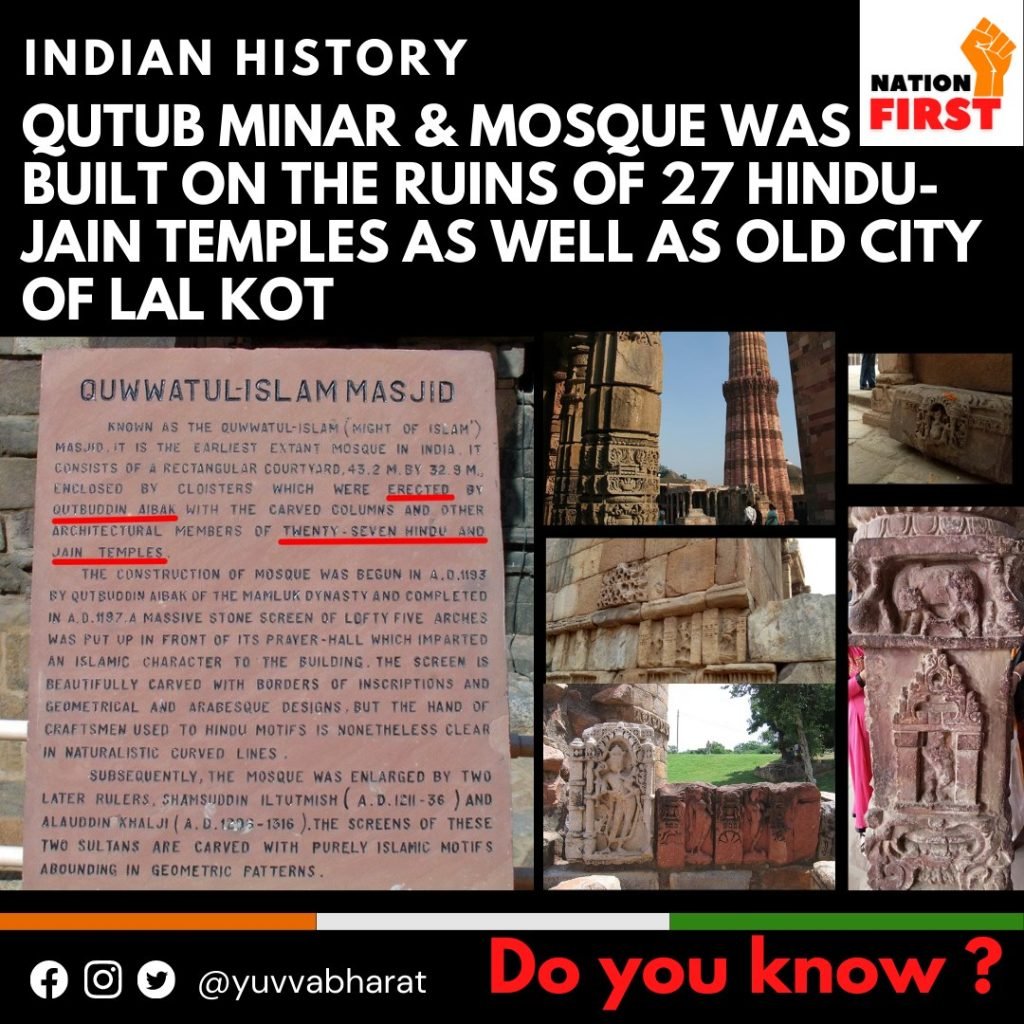Stones dislodged from the so-called Qutub Minar have Hindu images on one side with Arabic lettering on the other. Those stones have now been removed from the Museum. They clearly show that Muslim invaders used to remove the stone-dressing of Hindu buildings, turn the stones inside out to hide the image facial, and inscribe Arabic lettering on the new frontage.
Bits of #Sanskrit inscriptions can still be deciphered in the premises on numerous pillars and walls. Numerous images still adorn the cornices though disfigured.

The tower is but a part of the surrounding structures. It is not that while the #temples around are earlier #Hindu buildings there was sufficient space left in between for Qutubuddin to come and build a tower. It’s very ornate style proves that it is a Hindu tower. Mosque minarets have plane surfaces. Those who contend that the tower was meant to call the Muslim residents to prayer have perhaps never tried to go to the top and try to shout to the people below. Had they done so they would have found out for themselves that no one on the ground can hear them from that height. Such absurd claims have been made to justify the Muslim authorship of earlier Hindu buildings.
Another important consideration is that the entrance to the tower faces the north and not the west as is enjoined by #Islamic theology and practice.
At either side of the entrance is the stone lotus flower emblem which also proves that it was a Hindu building. The stone flowers are a very important sign of the Hindu authorship of #medieval buildings. Muslims never use such flowers on the buildings they construct.
The frieze Patterns on the tower show signs of tampering, ending abruptly or in a medley of incongruent lines. The Arabic lettering is interspersed with Hindu motifs like lotus buds hanging limp. #SayyadAhmadKhan, a staunch Muslim and a scholar have admitted that the tower is a Hindu building.
If one were to hoover in an airplane over the top of the tower the various galleries sliding into each other from top to bottom appear like a 24-petal lotus in full bloom. #24 being a multiple of 8 is #sacred in #Vedictradition. Even the brick red color of the tower is sacred to the Hindus.
The #Hindu title of the tower was #VishnuDhwaj (i.e. Vishnu’s standard) alias #VishnuStambh alias #DhruvStambh (i.e., a polar pillar) obviously connoting an #astronomical observation tower. The #Sanskrit inscription in #Brahmi script on the non-rusting iron pillar close by proclaims that the lofty standard of Vishnu was raised on the hillock named #Vishnupad Giri. That description indicates that a statue of the reclining Vishnu initiating the creation was consecrated in the central shrine there which was ravaged by #Mohammad #Ghori and his henchman #Qutubuddin. The pillar was raised at the command is an ancient Hindu king who had made great conquests in the East and the West.
The tower had seven stories representing the week of those only five exist now. The sixth was dismantled, hauled down, and re-erected on the lawns close by.
The seventh story had actually a statue of the four-faced Brahma holding the Vedas at the beginning of creation. Above Brahma was a white marble canopy with gold bell patterns laid in it. The top three stories were in mle. They were ravaged by iconoclastic Muslims who detested the Brahma statue. The Muslim raiders also destroyed the reclining Vishnu image at the bottom.
The iron pillar was the Garud Dhwaj alias #GarudStambh, i.e, the sentinel post of the Vishnu temple.
On one side was an elliptical enclave formed by #27 #Nakshatra (constellation) temples. A gigantic red-stone, ornate gateway led to the sacred enclave known as #Nakshatralaya. Therefore gateway is traditionally known as Alaya-Dwar.



